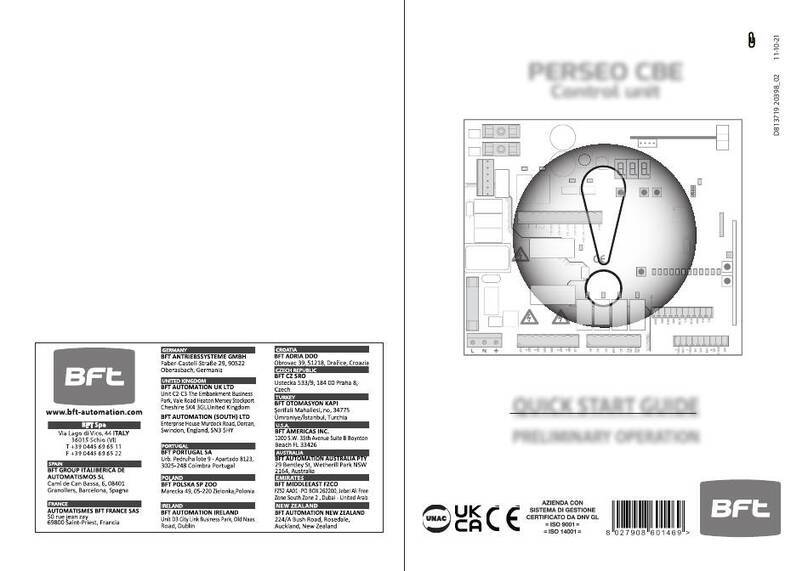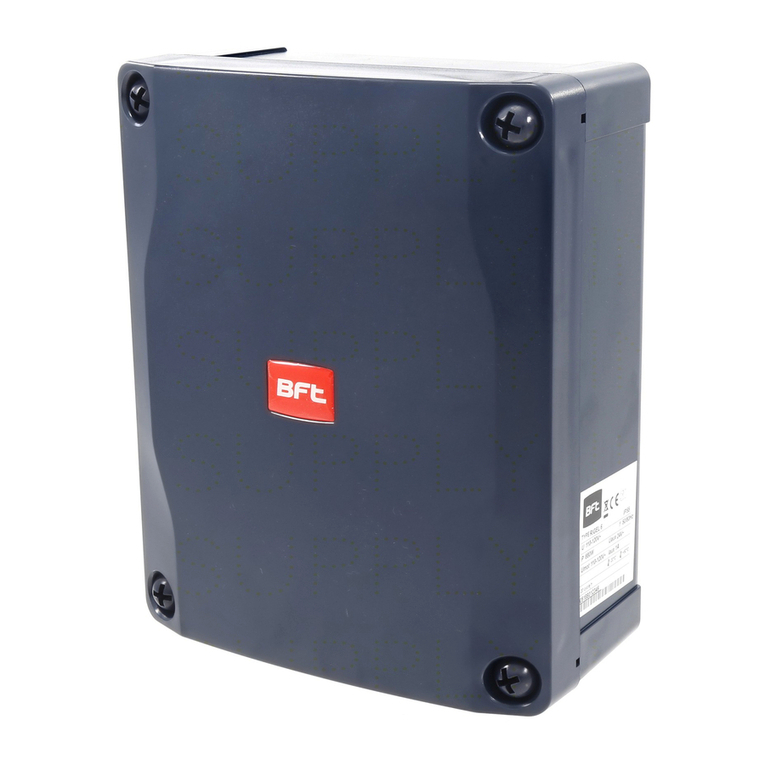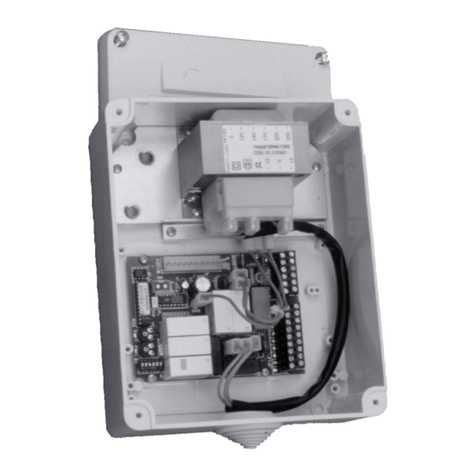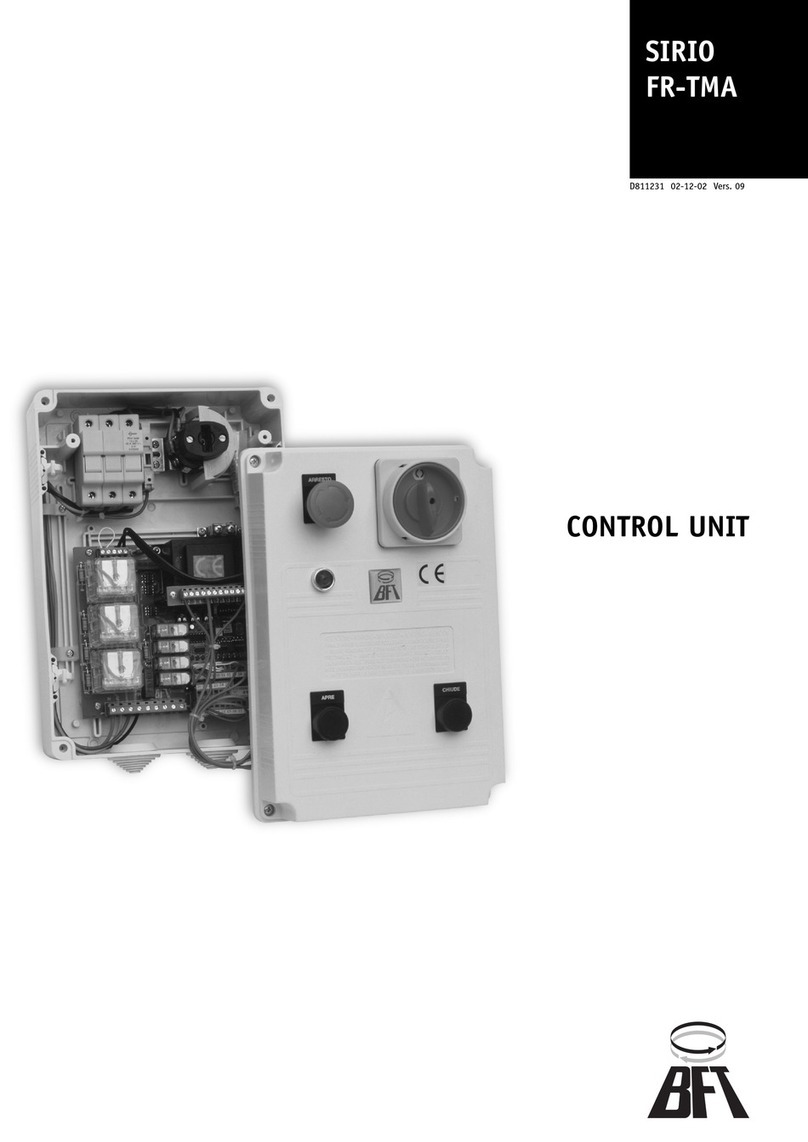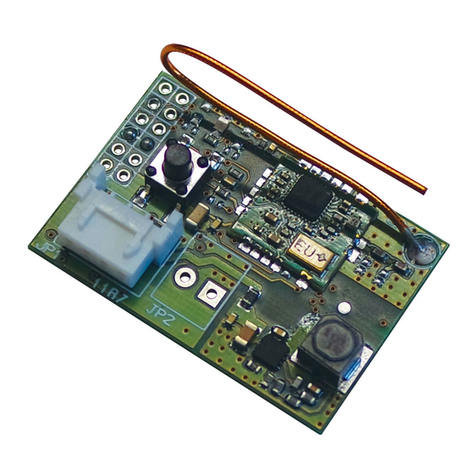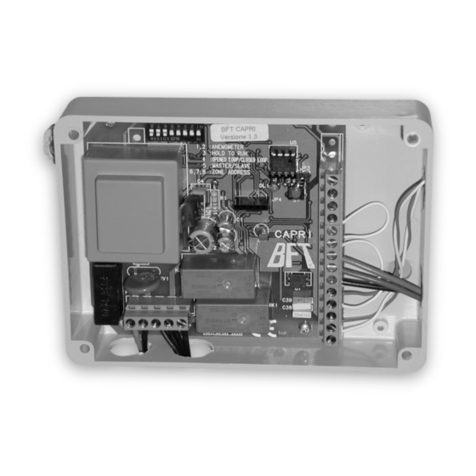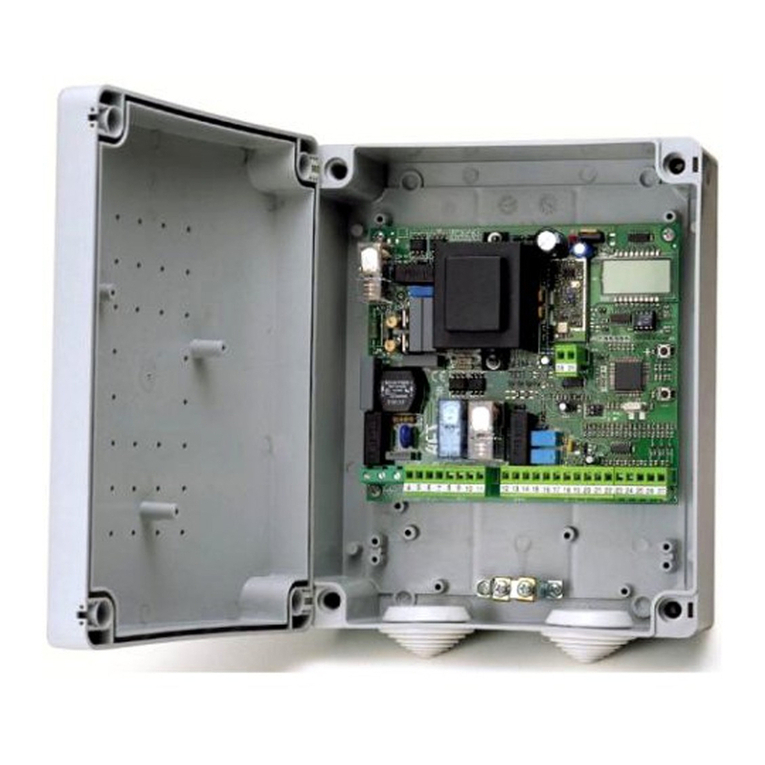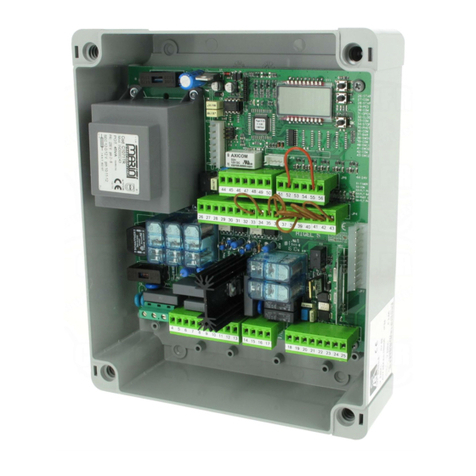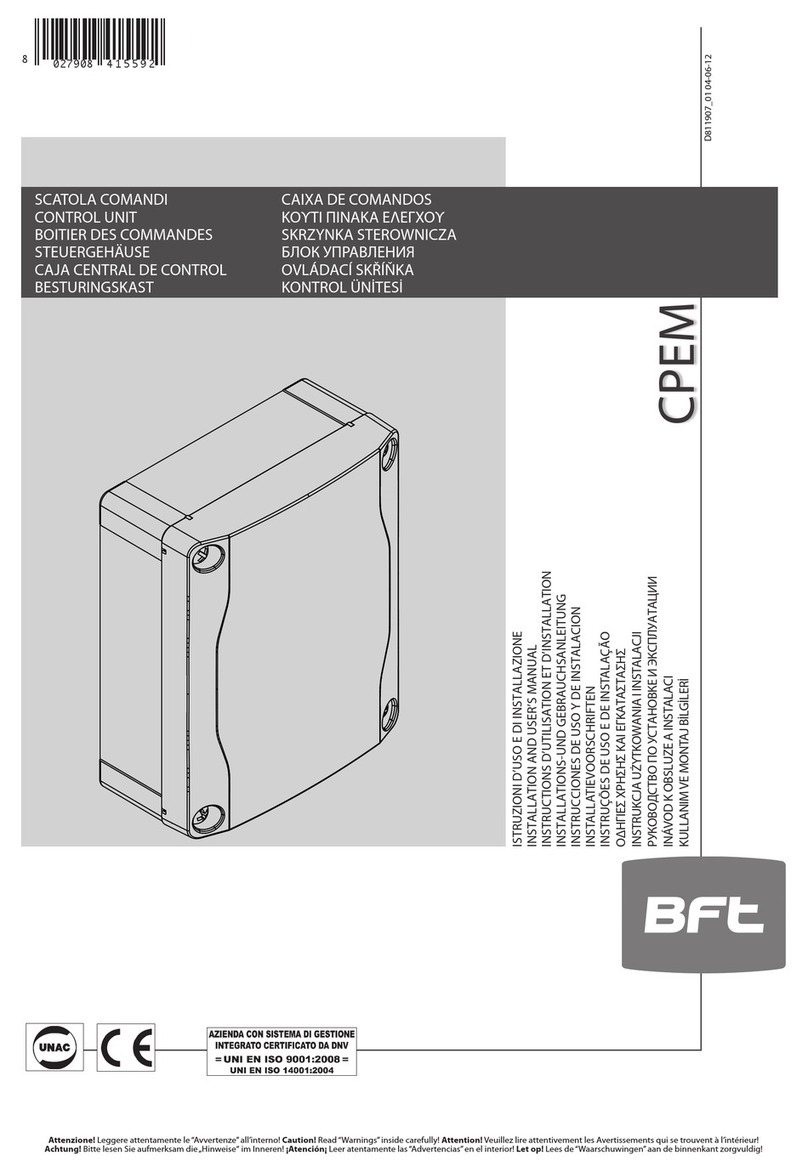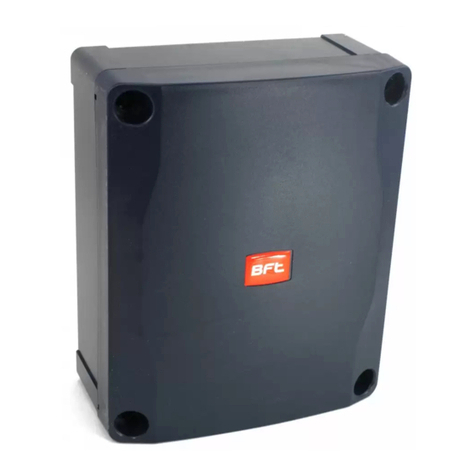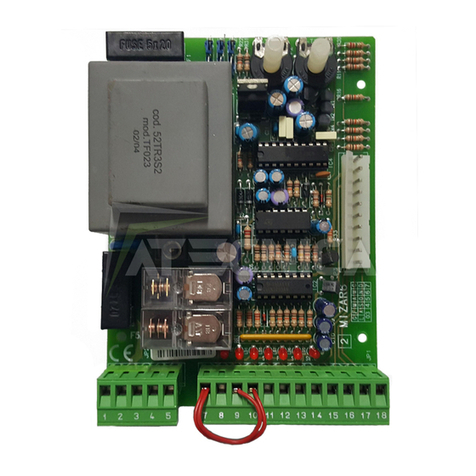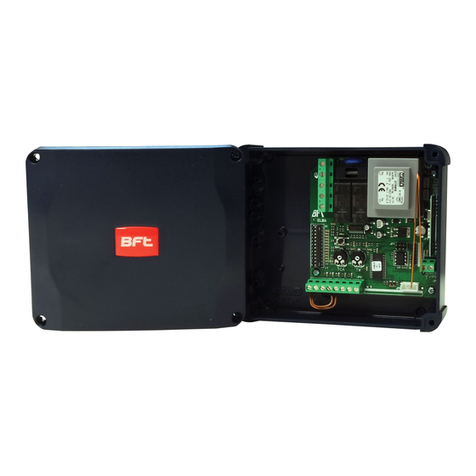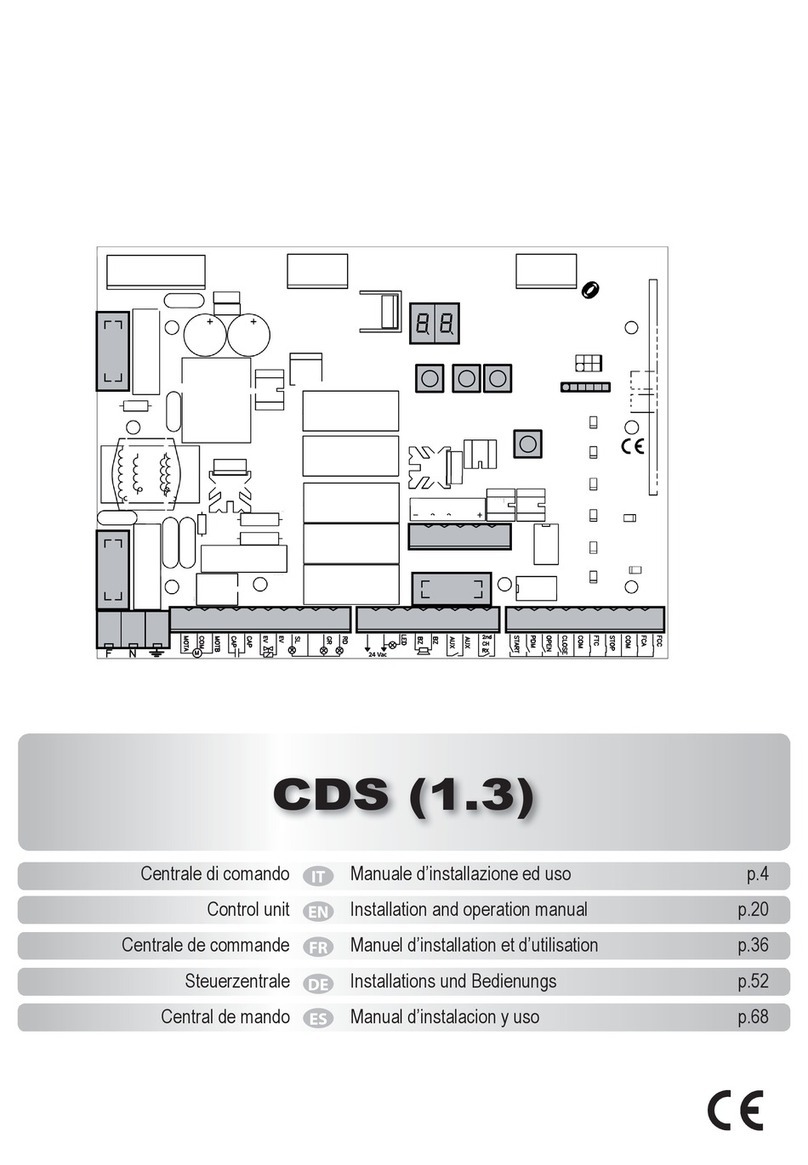MANUALE PER L’INSTALLAZIONE
ITALIANO
Nel ringraziarVi per la preferenza accordata a questo prodotto, la Ditta è
certa che da esso otterrete le prestazioni necessarie al Vostro uso. Leggete
attentamente l’opuscolo ”Libretto istruzioni” che lo accompagna in quanto
esso fornisce importanti indicazioni riguardanti la sicurezza, l’installazione,
l’uso e la manutenzione. Questo prodotto risponde alle norme riconosciute
della tecnica e delle disposizioni relative alla sicurezza.Confermiamo che è
conforme alle seguenti direttive europee: 89/336/CEE, 73/23/CEE, 98/37/
CE (e loro modifiche successive), applicando le seguenti norme tecniche
EN60335-1, PrEN12453, PrEN12445.
AVVERTENZE
Nelle operazioni di cablaggio ed installazione riferirsi alle norme vigenti e
comunque ai principi di buona tecnica.
AVVERTENZE
Qualunque interventosui componentidell’automazionedeveessereeseguito
da personale qualificato (installatore).
1) GENERALITÀ
Il quadro, dotato di centralina a microprocessore, è adatta a controllare un
attuatore monofase o trifase per cancello scorrevole oppure sezionale in
ambiente industriale.
Dispone di pulsanti di apre, chiude, stop (SIRIO FR TMA - SIRIO MA).
Dispone di interruttore lucchettabile e di luce spia di segnalazione anomalie
(es.: sblocco attivo, intervento extracorsa) (SIRIO FR TMA).
Una serie di leds consente la verifica o l’individuazione di anomalie di fun-
zionamento della centralina stessa o dei dispositivi collegati. La centralina
è dotata di Dip-switch e Trimmer che ne consentono la configurazione e la
taratura.Autodiagnosi: la centralina consente di effettuare il controllo dei relè
di marcia e dei dispositivi di sicurezza (fotocellule, costa sensibile, ecc.),
prima di eseguire ogni manovra.
2) SICUREZZA GENERALE
ATTENZIONE! Una installazione errata o un uso improprio del prodotto,
può creare danni a persone, animali o cose.
• Leggete attentamente l’opuscolo ”Avvertenze” ed il ”Libretto istruzioni”
che accompagnano questo prodotto, in quanto forniscono importanti indi-
cazioni riguardanti la sicurezza, l’installazione, l’uso e la manutenzione.
• Smaltire i materiali di imballo (plastica, cartone, polistirolo, ecc.) secondo
quantoprevisto dallenormevigenti.Nonlasciarebustedinylone polistirolo
a portata dei bambini.
• Conservare le istruzioni per allegarle al fascicolo tecnico e per consulta-
zioni future.
• Questoprodotto è statoprogettato ecostruitoesclusivamente perl’utilizzo
indicato in questa documentazione. Usi non indicati in questa documen-
tazione potrebbero essere fonte di danni al prodotto e fonte di pericolo.
• LaDittadeclinaqualsiasiresponsabilitàderivantedall’usoimproprioodiverso
da quello per cui è destinato ed indicato nella presente documentazione.
• Non installare il prodotto in atmosfera esplosiva.
• La Ditta declina qualsiasi responsabilità dall’inosservanza della Buona
Tecnica nella costruzione delle chiusure (porte, cancelli, ecc.), nonché
dalle deformazioni che potrebbero verificarsi durante l’uso.
• L’installazione deve essere in accordo con quanto previsto dalle Direttive Eu-
ropee: 89/336/CEE, 73/23/CEE, 98/37/CEE e loro modifiche successive.
• Toglierel’alimentazioneelettrica,primadiqualsiasiinterventosull’impianto.
Scollegare anche eventuali batterie tampone se presenti.
• Prevedere sulla rete di alimentazione dell’automazione, un interruttore
o un magnetotermico onnipolare con distanza di apertura dei contatti
uguale o superiore a 3,5 mm.
• Verificare che a monte della rete di alimentazione, vi sia un interruttore
differenziale con soglia da 0.03A.
•Per la versione SIRIO MA l’alimentazione del quadro deve essere protetta
da 3 fusibili con valore massimo di 4A/400 V~. I fusibili vanno scelti in
modo che intervangono in caso di bloccaggio del motore.
• Verificare se l’impianto di terra è realizzato correttamente: collegare tutte
le parti metalliche della chiusura (porte, cancelli, ecc.) e tutti i componenti
dell’impianto provvisti di morsetto di terra.
• La Ditta declina ogni responsabilità ai fini della sicurezza e del buon
funzionamento dell’automazione se vengono impiegati componenti di
altri produttori.
• Usare esclusivamente parti originali per qualsiasi manutenzione o ripa-
razione.
• Non eseguire alcuna modifica ai componenti dell’automazione se non
espressamente autorizzata dalla Ditta.
• Istruire l’utilizzatoredell’impianto per quantoriguardai sistemidicomando
applicati e l’esecuzione dell’apertura manuale in caso di emergenza.
• Non permettere a persone e bambini di sostare nell’area d’azione del-
l’automazione.
• Non lasciare radiocomandi o altri dispositivi di comando alla portata dei
bambini onde evitare azionamenti involontari dell’automazione.
• L’utilizzatore deve evitare qualsiasi tentativo di intervento o riparazione
dell’automazione e rivolgersi solo a personale qualificato.
• Tutto quello che non è espressamente previsto in queste istruzioni, non
è permesso.
• L’installazione deve essere fatta utilizzando dispositivi di sicurezza e
comandi conformi alla EN 12978.
3) DATI TECNICI
Alimentazione (*): ...................................trifase 400V~ ; monofase 230V~
Corrente uscita motore: ........................................... 2A/400V~; 4A/230V~
Corrente commutaz.motori: .................................. 8A/400V~ ; 12A/230V~
Isolamento rete - bassa tensione: ................................. > 2MOhm 500V
Rigidità dielettrica rete/bt: ........................................................... 3750V~1’
Potenza massima motore: ......................................................750W: 375W
Alimentazione accessori: ........................................ 24V~/0.5A: 24V~/0.5A
Spia cancello aperto: .......................................................24V/3W: 24V/3W
Lampeggiatore: ........................................................230V/40W: 230V/40W
Fusibili: .......................................................................................... vedi fig.1
Dimensioni: .................................................................................vedi fig.1A
(*)(altre tensioni a richiesta)
4) COLLEGAMENTI (Fig.3)
AVVERTENZE - Nelle operazioni di cablaggio ed installazione riferirsi alle
norme vigenti e comunque ai principi di buona tecnica.
I conduttori alimentati con tensioni diverse, devono essere fisicamente
separati, oppure devono essere adeguatamente isolati con isolamento
supplementare di almeno 1mm.
I conduttori devono essere vincolati da un fissaggio supplementare in pros-
simità dei morsetti, per esempio mediante fascette.
ATTENZIONE! Per il collegamento alla rete, utilizzare cavo multipolare
di sezione minima 3x1.5mm2e del tipo previsto dalle normative vigenti.
A titolo di esempio, se il cavo è all’esterno (all’aperto), deve essere
almeno pari a H07RN-F mentre, se all’interno (in canaletta),deve essere
almeno pari a H05 VV-F con sezione 3x1.5mm2.
N.B.:Prima di collegare la centralina alla rete, controllare che il morsetto JP5
(cambio tensione), sia predisposto per la giusta tensione di lavoro.
Laschedavienefornitaconunaserie dimorsetti ponticellati.Ipontiriguardano
i morsetti: 26-29, 26-30, 26-31, 26-35. Se questi morsetti non
vengano utilizzati, lasciarli ponticellati. Nella morsettiera ausiliaria SSBB1,
sono ponticellati i morsetti 6-7, 8-9, 10-11. Nel caso questi morsetti non
vengano utilizzati, lasciarli ponticellati.
QUADRO
Importante: L’alimentazione del quadro, va collegata ai morsetti del sezio-
natore “S” (SIRIO FR TMA).
S - TRIFASE
R-S-T-N ...............................................Trifase 400V ±10% 50Hz + Neutro.
ATTENZIONE! (cambio tensione JP5/39-40).
S - MONOFASE
R-N ................................................................Monofase 230V ±10% 50Hz.
ATTENZIONE! (cambio tensione JP5/40-41).
CENTRALINA
JP1 - TRIFASE
1-2-3-4 Alimentazione trifase+neutro 400V.
(1 Neutro, 2-3-4 fase)(N.B.: ponte di JP5 tra 39-40).
5-6-7 Collegamento motore trifase.
8-9 Uscita 230V~per luce lampeggiante.
JP1 MONOFASE
1-2 Alimentazione monofase 230V.
(1 Neutro, 2 fase) (N.B.: ponte di JP5 tra 40-41).
5-6-7 Collegamentomotoremonofase(5-7marciamotoreecondensatore,
6 comune).
8-9 Uscita 230V~per luce lampeggiante.
JP2
10-11 Uscita 24V~(3W) per luce spia di segnalazione sblocco motore e/o
porta pedonale. La spia si accende a motore sbloccato (manovra
manuale) o a porta pedonale aperta.
11-12 Alimentazione accessori 24V~ e ricevitori dispositivi di sicurezza
non sottoposti a verifica.
12-13 Alimentazione 24VTx solo per trasmettitori dispositivi di sicurezza
sottoposti a verifica.
14 Ingresso LOOP1 dell’anello di verifica sicurezze (vedere fig.5).
15 Ingresso LOOP2 dell’anello di verifica sicurezze (vedere fig.5).
16-17 Uscita secondo canale radio scheda ricevente bicanale (n.o.).
18-19 Ingresso antenna scheda radioricevente (18 segnale, 19 calza).
8 -SIRIO FR-TMA / SIRIO TMA / SIRIO MA - Ver. 13
D811231_13













